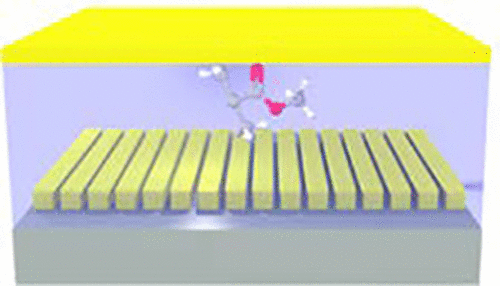当前位置:
X-MOL 学术
›
ACS Photonics
›
论文详情
Our official English website, www.x-mol.net, welcomes your feedback! (Note: you will need to create a separate account there.)
Strong Coupling beyond the Light-Line
ACS Photonics ( IF 7 ) Pub Date : 2020-08-06 , DOI: 10.1021/acsphotonics.0c00552 Kishan S. Menghrajani 1 , William L. Barnes 1
ACS Photonics ( IF 7 ) Pub Date : 2020-08-06 , DOI: 10.1021/acsphotonics.0c00552 Kishan S. Menghrajani 1 , William L. Barnes 1
Affiliation

|
Strong coupling of molecules placed in an optical microcavity may lead to the formation of hybrid states called polaritons; states that inherit characteristics of both the optical cavity modes and the molecular resonance. Developing a better understanding of the matter characteristics of these hybrid states has been the focus of much recent attention. Here, as we will show, a better understanding of the role of the optical modes supported by typical cavity structures is also required. Typical microcavities used in molecular strong coupling experiments support more than one mode at the frequency of the material resonance. While the effect of strong coupling to multiple photonic modes has been considered before, here we extend this topic by looking at strong coupling between one vibrational mode and multiple photonic modes. Many experiments involving strong coupling make use of metal-clad microcavities, ones with metallic mirrors. Metal-clad microcavities are well-known to support coupled plasmon modes in addition to the standard microcavity mode. However, the coupled plasmon modes associated with a metal-clad optical microcavity lie beyond the light-line and are thus not probed in typical experiments on strong coupling. Here we investigate, through experiment and numerical modeling, the interaction between molecules within a cavity and the modes both inside and outside the light-line. Making use of grating coupling and a metal-clad microcavity, we provide an experimental demonstration that such modes undergo strong coupling. We further show that a common variant of the metal-clad microcavity, one in which the metal mirrors are replaced by distributed Bragg reflector also show strong coupling to modes that exist in these structures beyond the light-line. Our results highlight the need to consider the effect of beyond the light-line modes on the strong coupling of molecular resonances in microcavities and may be of relevance in designing strong coupling resonators for chemistry and materials science investigations.
中文翻译:

超越光线路的强耦合
放置在光学微腔中的分子的强耦合可能导致形成称为极化子的杂化态。既继承了光腔模和分子共振特性的状态。对这些杂化状态的物质特性的更好的了解一直是近期关注的焦点。正如我们将显示的,这里还需要更好地理解典型腔结构所支持的光学模式的作用。分子强耦合实验中使用的典型微腔在材料共振频率下支持一种以上的模式。虽然以前已经考虑过强耦合到多个光子模式的效果,但在这里,我们通过研究一种振动模式和多个光子模式之间的强耦合来扩展本主题。许多涉及强耦合的实验都使用带有金属镜的金属包覆微腔。众所周知,除了标准的微腔模式外,覆金属的微腔还支持耦合等离子体激元模式。但是,与金属包覆的光学微腔相关的耦合等离子体激元模式超出了光线范围,因此在典型的强耦合实验中没有进行探测。在这里,我们通过实验和数值模型研究腔内分子与光线线内外的模式之间的相互作用。利用光栅耦合和金属包覆的微腔,我们提供了一种实验证明,这些模式会发生强耦合。我们进一步表明,金属包覆微腔的常见变体 用分布式布拉格反射器代替金属镜的那一者也显示出与这些结构中存在于光线之外的模式的强耦合。我们的结果强调需要考虑超出光线模式对微腔中分子共振的强耦合的影响,这可能与设计用于化学和材料科学研究的强耦合共振器有关。
更新日期:2020-09-16
中文翻译:

超越光线路的强耦合
放置在光学微腔中的分子的强耦合可能导致形成称为极化子的杂化态。既继承了光腔模和分子共振特性的状态。对这些杂化状态的物质特性的更好的了解一直是近期关注的焦点。正如我们将显示的,这里还需要更好地理解典型腔结构所支持的光学模式的作用。分子强耦合实验中使用的典型微腔在材料共振频率下支持一种以上的模式。虽然以前已经考虑过强耦合到多个光子模式的效果,但在这里,我们通过研究一种振动模式和多个光子模式之间的强耦合来扩展本主题。许多涉及强耦合的实验都使用带有金属镜的金属包覆微腔。众所周知,除了标准的微腔模式外,覆金属的微腔还支持耦合等离子体激元模式。但是,与金属包覆的光学微腔相关的耦合等离子体激元模式超出了光线范围,因此在典型的强耦合实验中没有进行探测。在这里,我们通过实验和数值模型研究腔内分子与光线线内外的模式之间的相互作用。利用光栅耦合和金属包覆的微腔,我们提供了一种实验证明,这些模式会发生强耦合。我们进一步表明,金属包覆微腔的常见变体 用分布式布拉格反射器代替金属镜的那一者也显示出与这些结构中存在于光线之外的模式的强耦合。我们的结果强调需要考虑超出光线模式对微腔中分子共振的强耦合的影响,这可能与设计用于化学和材料科学研究的强耦合共振器有关。


























 京公网安备 11010802027423号
京公网安备 11010802027423号